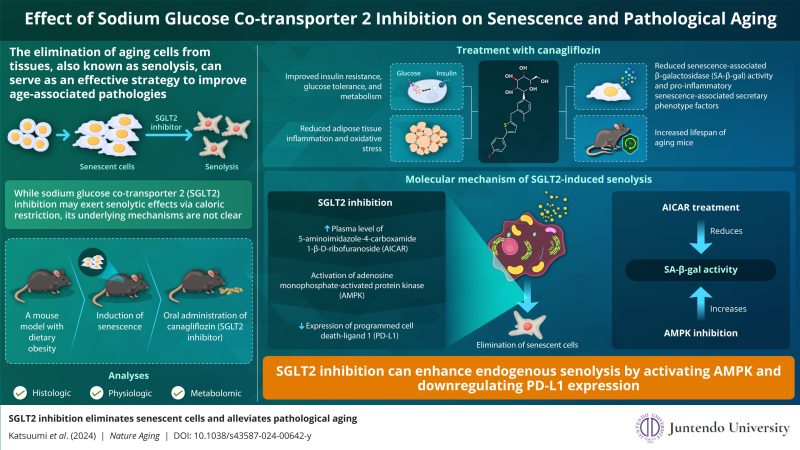New study highlights senescent cell removal mechanisms of canagliflozin, a sodium glucose co-transporter 2 inhibitor

Aging-related physiological decline and the accumulation of senescent or aging cells in bodily tissues can trigger a number of diseases. The removal of senescent cells, also known as “senolysis,” can therefore serve as an effective strategy against aging-related diseases. Now, researchers from Japan have uncovered novel molecular mechanisms underlying the senolytic effects of canagliflozin—a sodium glucose co-transporter 2 inhibitor used to control blood glucose levels.
The process of aging is accompanied by a decline in physiological functions, which can lead to cardiovascular, neurodegenerative, and metabolic diseases. Aging of cells, also known as cellular senescence, is a process in which a cell ages and permanently stops dividing but does not die. The accumulation of such senescent cells in tissues is then known to contribute to age-associated diseases. Elimination of senescent cells—senolysis—can therefore serve as an effective therapeutic strategy for the improvement of physiological function and prevention of aging-related diseases.
However, conventional senolytic agents that directly inhibit cellular aging signals can have concerning and long-term side effects. There is thus a need for the development of novel senolytic drugs to help prevent age-associated diseases more safely and effectively.
Previous studies have shown that caloric restriction or reduction of average daily caloric intake is associated with longevity and decreased tissue accumulation of senescent cells. In addition, inhibition of sodium glucose co-transporter 2 (SGLT2)—a key protein involved in glucose transport—is effective in reducing blood glucose levels, leading to loss of calories. But can these effects be extended to senescent cell removal?
To find out, Professor Tohru Minamino and Dr. Goro Katsuumi from the Department of Cardiovascular Biology and Medicine, Juntendo University, Japan, along with their team of researchers, conducted a series of experiments to understand the potential senolytic effect of the SGLT2 inhibitor—canagliflozin, and its underlying molecular mechanisms.
Giving further insight into their work published in Nature Aging, Prof. Minamino states, “Unlike the conventional senescent cell-eliminating agents, SGLT2 inhibitors are a new class of therapeutic agents with fewer side effects as they promote senescent cell elimination by activating the immune system.”
The researchers used a mouse model of dietary obesity, in which mice were fed with a high fat diet (HFD) to induce cell senescence. Next, they treated the mice with canagliflozin (administered orally), and examined them for changes in glucose metabolism and HFD-induced senescence.
Notably, canagliflozin treatment led to significant improvement in glucose metabolism and reduced insulin resistance, compared to HFD control animals. Further, the treatment led to a reduction in senescence-related markers including senescence-associated β-galactosidase (SA-β-gal) activity and pro-inflammatory senescence-associated secretary phenotype (SASP) factors.
Furthermore, mice treated with canagliflozin showed decreased inflammation and oxidative stress in adipose tissues. Additionally, in vivo fluorescence studies also demonstrated that canagliflozin attenuated SA-β-gal activity and eliminated senescent cells.
Next, the researchers sought to uncover the molecular mechanisms underlying the senolytic activity of canagliflozin using metabolomic analysis (assessment of changes in metabolites). They found that SGLT2 inhibition led to a significant increase in the plasma level of 5-aminoimidazole-4-carboxamide 1-β-D-ribofuranoside (AICAR)—a metabolite known to activate adenosine monophosphate-activated protein kinase (AMPK).
They also noted a subsequent increase in the levels of activated AMPK. Notably, mice treated with AICAR exhibited reduced SA-β-gal activity, similar to SGLT2 inhibition. Conversely, inhibition of AMPK led to an increase in SA-β-gal activity, corroborating the role of AICAR and AMPK in senolysis induced by SGLT2 inhibition.
The immune system and immune checkpoint factor—programmed cell death-1 (PD-1)/PD-L1 are known to be actively involved in cell senescence. Further, AMPK is known to negatively regulate the expression of PD-L1. Thus, the researchers speculated that AMPK activation following SGLT2 inhibition might regulate PD-L1 expression.
Sure enough, SGLT2 inhibition with canagliflozin significantly reduced the previously elevated number of PD-L1-positive senescent cells in HFD-fed mice. Conversely, suppression of immune cells following canagliflozin treatment led to an increase in senescent cells, indicating that the senolytic effects of canagliflozin were partly mediated by the immune system.
In addition to the above findings, the researchers also noted that SGLT2 inhibition could ameliorate specific aging-induced pathologies by removing senescent cells, improving physical activity, and increasing the life span of treated animals. Overall, these findings highlight the clinical potential of SGLT2 inhibition as an effective senolytic strategy in the management of aging-related disorders.
Prof. Minamino says, “In this study, we were able to demonstrate improvement against diabetes, arteriosclerosis, premature aging, and frailty, as well as a prolonged life span in response to SGLT2 inhibition. SGLT2 inhibitors may be applied in the treatment of various aging-related diseases, including Alzheimer’s disease, in the future.”
More information:
SGLT2 inhibition eliminates senescent cells and alleviates pathological aging, Nature Aging (2024). DOI: 10.1038/s43587-024-00642-y. www.nature.com/articles/s43587-024-00642-y
Provided by
Juntendo University Research Promotion Center
Citation:
New study highlights senescent cell removal mechanisms of canagliflozin, a sodium glucose co-transporter 2 inhibitor (2024, May 30)
retrieved 30 May 2024
from https://medicalxpress.com/news/2024-05-highlights-senescent-cell-mechanisms-canagliflozin.html
This document is subject to copyright. Apart from any fair dealing for the purpose of private study or research, no
part may be reproduced without the written permission. The content is provided for information purposes only.








